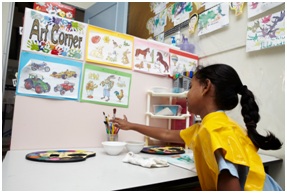A Window Into Your Child's Mind


Children’s drawings are under-utilised when it comes to lesson planning. A good lesson plan is one that connects with children’s interests and needs — and a drawing can be used to understand a child better. After all, a drawing is a window into a child’s mind and provides insights to a child’s prior knowledge and experiences, his conceptions and misconceptions of people, things and events.
Four types of Knowledge | Six Cognitive Processes and Descriptive Indicators | |
Factual | Level 1: Remember | · Identify and label things |
Conceptual | Level 2: Understand | · Interpret by giving examples · Classify by organising and categorising · Infer by concluding/ predicting, comparing and explaining causal-effect |
Procedural | Level 3: Apply | · Execute by drawing a procedure to determine what/ where/ how/ when/ why |
Metacognition | Level 4: Analyse | · Differentiating · Attributing · Organising people/ events |
Level 5: Evaluate | · Checking based on criteria or standards · Critique by judging and detecting inconsistencies | |
Level 6: Create | · Generate by coming up with different ideas · Plan by designing a procedure to carry out an activity in the drawing · Produce by constructing or inventing in drawing a new model or product | |
When applying the framework to interpret children’s drawings, it is important to take into account the child’s verbal descriptions to understand the reasoning behind the drawing before applying the descriptive indicators.
Example 1: “Wild animals” drawing by a six-year-old boy

Child’s verbal descriptions:
1. “The hippo swimming around; people sit on the hippo.”
2. “The lion wants to chase the tiger.”
3. “The lion wants to chase this lion becos this lion loves this lion becos is cute.”
4. “Bat
wants to eat leaf scare to cross to the tree becos later eagle eat up the bat; so he fly fly.”
5. “Eagle got plaster; the bee sting; got bee hive.”
6. “Squirrel crawl up the tree; they eat nuts.”
- Remember – by identifying and labelling nine animals
- Understand – by classifying land animals, with the tiger, lion and hippo placed on a baseline. He also gave examples to clarify and represent how animals function or associate with something else (such as the tree and nuts)
e.g. “Orang-utan climb tree; squirrel climb tree to eat nuts.” Flying animals were categorised on the upper plane at almost same level with the rainbow and sun.
- Analyse – by organising animals in in groups relevant to the thematic idea of “wild animals”, which shows that he understands predator-prey relationships. He also differentiated a bat from an eagle; a tiger from
a lion; an orang-utan from a squirrel to tell a pictorial story of wild animals, and also made inferences by comparing, explaining, predicting, concluding the causal-effect of the lion, bat and eagle behaviours.
- Evaluate – by choosing carefully what animals represent “wild” (as compared to “farm”). The child’s creative invention of a new hybrid of snakes was proudly identified as “tiger-snake; rhino-snake-tiger” a synthesis of two to three unique features distinctive of the snake (a fork-tongue); tiger (orange stripes) and rhino (two grey horns).
- “Plaster on the eagle’s body” – relate this to veterinary practices/injured animals.
- The child’s new hybrid creations can lead to a session of making models of other hybrid animals.
- A possible class discussion on how animals love or care for each other (inspired by the child’s idea of cute lions that love and chase each other).
Dr Rebecca Chan is an adjunct lecturer with the SEED Institute in Early Childhood Education and in Art Education with the National Institute of Education / Nanyang Technological University (NIE/NTU), Visual and Performing Arts department. She is a consultant and practitioner of a childcare centre who works closely with teachers, children and parents. She also presents conferences, talks and workshops in Singapore and the United Kingdom.
Dr Chan is currently working with a publisher to print a step-by-step manual on using the framework to interpret children’s drawings to extend thinking and learning for curriculum planning.
|
You may also like

From Cabin to Classroom: Journey of an Outstanding Early Childhood Educator
The PDP modules allowed me to get creative with lesson ideas and keep up with the ever-changing Early Childhood sector.

Ms Farhana Binte Mohamed Hassan
Early Years Educator - PCF Sparkletots @ Pioneer Block 987D (CC)

More Than Just a Place for Food
Young children are highly inquisitive, and learn most effectively with activities that allow exploration and experimentation.

Kinderland @ Yio Chu Kang

Little Fingers Create Great Art - A Community Project by Kinderland and Skool4kidz
I believe this collaborative effort is a very meaningful contribution to the SG50 celebrations.

Kinderland and Skool4Kidz